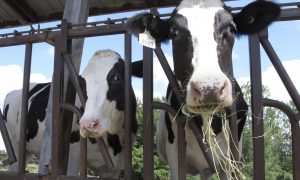
Protecting dairy calves from bovine respiratory disease (BRD), more commonly known as pneumonia, is not a simple task. However, it is critical to the long-term economic well-being of the dairy.
In nationwide surveys, it’s estimated that 12% to 16% of preweaned calves and 6% to 11% of weaned calves experience BRD.1 It’s also the No. 1 cause of mortality in preweaned and weaned dairy calves, with death losses of 2.3% and 1.5%, respectively.
When protecting your calves against BRD, it’s important to understand the animal’s immune system, the different types of vaccines and how each works to stimulate the animal’s immune system.
Mark van der List, DVM, Boehringer Ingelheim, shares insights to help producers understand the different approaches to protecting calves from BRD.
Building calf immunity
When a calf is born, its immune system isn’t fully developed. Since it has no antibodies in the blood to fight off pathogens or disease-causing viruses and bacteria, the calf relies on the maternal antibodies it receives via colostrum in the hours after birth.
“The first, and one of the most important, forms of protection we can provide newborn calves is quality colostrum,” said Dr. van der List. “Colostrum defends calves against the most common viral and bacterial infections found within their environment.”
These maternal antibodies bind to specific pathogens and destroy them, but they’re generally short-lived, gradually waning over the first few months of the calf’s life.
An approach to protecting young calves
For very early protection, some producers choose intranasal vaccines, because they may be administered to calves as young as 3 days of age.
“Intranasal vaccines create local immunity in the form of immunoglobulin A (IgA) antibodies,” Dr. van der List said. “These are the prevalent antibodies in the lining of the upper respiratory tract (nasal passage mucosa) where respiratory viruses and bacteria typically enter.” These IgA antibodies protect against respiratory pathogens in the airways before they can penetrate deeper into the lungs and really cause damage.
“Compared to injectable vaccines, intranasal vaccines produce a shorter duration of immunity,” Dr. van der List continued. “The main immune response from intranasal vaccines based on IgA antibodies doesn’t last as long as the immunoglobulin G (IgG) antibodies produced primarily by injectable vaccines.”
Dr. van der List pointed out that when administering an intranasal vaccine, it is important to vaccinate again at 30 days of age with an injectable modified-live virus (MLV) vaccine.
Injectable vaccines effectively protect young calves
In the past, it was believed there was no point in giving injectable respiratory vaccines before about 4 months of age, because they would be inactivated by maternal antibodies. But a recent study proves that’s not the case.
In the study, calves with maternal antibodies to bovine respiratory syncytial virus (BRSV) from colostrum were given an injectable modified-live virus respiratory vaccine for BRSV or a placebo at 30 days of age.3 The calves were then exposed to BRSV about 72 days later (approx. 3 months of age). Compared to calves that received a placebo, those administered the vaccine had fewer clinical signs and lung lesions, as well as less viral shedding.
These findings prove that an injectable respiratory vaccine, when given to calves at 30 days of age, can overcome maternal antibodies to stimulate a rapid response and provide protective immunity against BRSV.3 “That’s not to say all injectable vaccines can do this,” Dr. van der List said. “This particular product utilizes a unique adjuvant that protects vaccine antigens from maternal antibodies, thus enhancing the immune response, even in calves still maintaining high levels of maternal antibodies acquired from colostrum.”
Injectable vaccines stimulate mucosal and systemic immunity
“For many years, it was believed that only intranasal vaccines produced mucosal immunity with IgA antibodies and interferon, and that injectable vaccines were responsible only for systemic immunity with IgG antibodies,” continued Dr. van der List. “Again, it’s not that cut and dried, because newer technologies are available.”
The BRSV study found that calves administered the injectable vaccine developed an IgA mucosal immune response to BRSV, as measured by antibodies in nasal secretions. Vaccinated calves also had significantly higher interferon levels than their unvaccinated counterparts.3
“We now know we don’t have to give intranasal vaccines in order to stimulate the production of IgA antibodies and interferons in the mucosa of calves that are at least 30 days of age,” clarified Dr. van der List.
Injectable vaccines provide broad-spectrum, longer-lasting immunity
Preventing respiratory disease goes beyond an animal’s first lines of defense with antibodies created in the lining of the nasal passages and airways.
“Animals need protection from the respiratory pathogens that get past defense mechanisms in the airway lining and reach the lungs. Although some intranasal vaccines may elicit a systemic response, it’s typically not as robust or long-lasting as what occurs with injectable vaccines,” reported Dr. van der List.
“If you start with an intranasal vaccine in newborn calves, then at about 1 to 2 months of age, it’s important to stimulate the kind of strong, long-term systemic immunity that’s only possible with injectable vaccines,” he continued.3
Injectable respiratory vaccines also protect calves against important pathogens not covered by intranasal vaccines, such as bovine viral diarrhea virus (BVDV) Type 1 & 2. Consideration should be given to injectable vaccines that protect against the most prevalent BVDV, Type 1b.4
A place for both types of vaccines
“Intranasal vaccines may benefit newborn dairy calves that are likely to be exposed to respiratory pathogens early in life,” Dr. van der List noted. “Injectable vaccines also have a place in disease prevention, and when used at 30 to 60 days of age (pre-weaning), can provide a broader, more long-lasting immunity.”
Every herd is different, so remember to consult a veterinarian to develop the most effective protocols for your operation.























